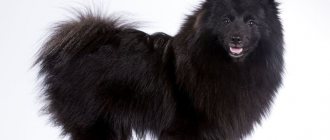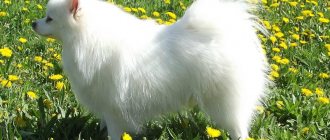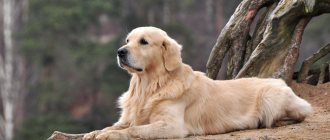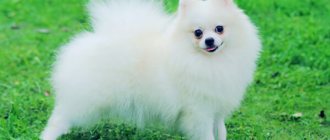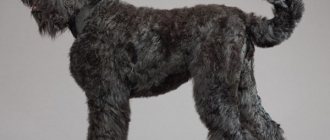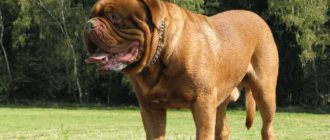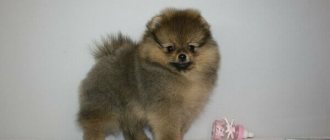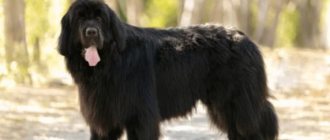| Origin: | Germany |
| Usage: | companion, watchman |
| Color: | various |
| Dimensions: | 20-55 cm |
| Lifespan: | 15 years |
The German Spitz is absolutely charming. He resembles a cross between a fox, a bear cub and a lion. And behind the sweet appearance hides a fearless guard, a curious mischief-maker and an understanding companion. This fur ball with triangular ears and beady eyes has captivated thousands of people since ancient Rome and continues to win the love of millions of dog lovers today.
Standard requirements
The German Spitz breed standard differs in different countries. Thus, FCI and RKF classify all varieties into one group. And in the USA and England, the Keeshond and the German miniature Spitz are considered separate species.
5 types – 5 standards
The FCI German Spitz breed standard identifies the following species:
- German Wolfspitz Keeshond. The color is wolf (zonal gray), height – 43-55 cm.
- Large German Spitz or Grossspitz. Reaches 42-50 cm. Color – brown, black, white.
- Medium German Spitz or Mittelspitz. Color – red, black, zoned, brown, white. Other suits provided for by the standard are allowed. Height – 30-38 cm, weighs up to 11 kg.
- Small German Spitz or Kleinspitz. The suit options are the same as for the Middle Spitz. Size – 23-29 cm.
- German Miniature Spitz, also Pomeranian or Pomeranian. The color is the same as that of the medium and small German Spitz. Height 18-22 cm.
The standard allows other colors: cream, sable - orange or cream, black and tan and spotted colors. The last suit implies a basic white background with spots. It can be black and white, brown, gray or orange and white.
The weight of the German Spitz corresponds to its size. Height below 18 cm is considered a defect. However, fashion dictates its own rules, and today the German Dwarf Spitz has appeared.
Although the German Mini Spitz is not recognized as a standard breed, its popularity is off the charts. It comes in two types: bear-type and doll-type. The dogs of these varieties have cute faces that resemble seals or bear cubs. However, they are living toys. Pets carry the dwarfism gene. Such animals are a degeneration of the breed.
Wolfspitz photo
Photo of Grossspitz.
Photo of the Mittelspitz
Kleinspitz photo
Photo of the orange
General requirements
Apart from differences in size and color, the German Spitz breed standard is common to all dogs. The table below reflects it.
| Options | Characteristic |
| Frame | The back is not long, straight with a wide loin. The belly is tucked in, the chest is wide and voluminous. |
| Leather | Fits tightly to the body, without folds. |
| Head | Medium, wedge-shaped, but not sharp. The ratio of the muzzle to the skull in Keeshonds, large and medium-sized dogs is 2:3, in small and Pomeranians it is 2:4. |
| Neck | Relatively long, wide at the shoulders, with a slight bend. Decorated with a mane. |
| Ears | Small, triangular, pointed. |
| Eyes | Almond-shaped, small, stand slantingly. The color is dark, the eyelids are black, in brown dogs they match the color. |
| Nose | Small, round, matching color. During the seasonal change of coat, in cream-colored dogs and in old dogs, lightening the middle of the lobe is acceptable. |
| Lips | Without jowls, tightly covering the teeth, pigmented to match the color. |
| Bite | Scissor-shaped, perhaps pincer-shaped. |
| Forelegs | With well-developed muscles, elbows pressed to the chest. |
| Hind limbs | Muscular, straight. Abundantly cleaned - so-called. skirt or pants. |
| Paws | In the shape of a cat's paw. The pads and claws are black. |
| Tail | It stands high, rises from the base to the top, is twisted into a ring and lies on the back. |
| Wool | Double, without curls. The spine is straight, the undercoat is abundant and fluffy. The neck, chest, belly, back, tail, back of the limbs are covered with long hair. An adult dog's coat should be silky to the touch, not cottony or fluffy. |
History of breeding and its purpose
Scientists cannot give the exact date and place of origin of this breed. It is thought to have descended from the ancestors of an ancient Neolithic "peat dog" The remains of these animals were found in 1862 in pile settlements of Swiss lakes and dated back to 2500-1900 BC .
The homeland is Germany. This oldest breed gets its name from the word “spitz” , which literally means “pointed” .
This is the oldest breed in Central Europe. It was brought from Scandinavia to Central Europe by the Vikings . Initially, such dogs were three times larger in size than modern representatives of this breed and weighed 14 kg. Over time, the size of the animals decreased.
In ancient times, the Grossspitz and Middle Spitz were popular among farmers and middle-class people. These animals were used to guard the home, pasture , and also for catching rodents .
In the second half of the 19th century, the first German Spitz club was founded Charles Kammerer . The club developed modern breed standards and founded a Stud Book. Then these dogs were conditionally divided into three subgroups: large, medium and small. Nowadays there are 5 varieties of this breed.
At the beginning of the 19th century, they came to America , where local breeders improved the standard. In the USA and Great Britain, the Pomeranian Spitz (Zwergspitz, dwarf Spitz) and Keeshond (Wolfspitz) are separate breeds and have their own national standards. They are distinguished by a strong body constitution, good health and mobility.
During the reign of Queen Victoria of England in 1870, small Spitz dogs became popular at court. Then work began on breeding a dwarf form . Now they are known as Pomeranians (in honor of the historical region of Germany - Pomerania). A little later, the English Club of German Spitz was founded in England, which holds exhibitions.
France preferred breeding medium-sized animals without the beloved “lion” collar.
The Netherlands and Denmark primarily developed the performance qualities by using them on rodent fishing vessels. The German Wolfspitz (Keeshond) was bred in the Netherlands.
In Russia, this breed appeared closer to the 20th century and gained popularity among the bourgeoisie. This breed developed in Russia in the 21st century.
Behavior
The character of the German Spitz is unique. From the first days of its existence, the breed developed alongside man, helping him farm and brighten up his days. That's why dogs know how to adapt. With calm owners, they lie on the sofa under the steady hum of the TV, with lovers of sports and outdoor activities, they explore the world.
This does not mean that dogs are couch potatoes. They are active, they need to play, walk and be mischievous every day. It’s just that the character of a German Spitz depends on the temperament of the owner. The saying that dogs are like their owners suits this breed like no other. With choleric people they will be hyperactive, with phlegmatic people they will be calm.
All types of German Spitz are sociable and cheerful. They love family. But the attitude towards strangers is different. Decorative breeds are usually friendly, while others are wary of strangers.
Like any dog, Spitz dogs have advantages and disadvantages. They are devoted to their owner and household members, love affection and participate in everyday affairs. But they cannot stay alone for long, even in the next room. You should prepare for the fact that a furball will follow a person around the apartment and poke its nose everywhere. Sometimes it's annoying.
Another disadvantage is excessive loud barking. You can recognize a German Spitz by its abrupt voice, even without seeing the dog. They need to be told everything about even minor events - the arrival of neighbors, a conversation behind a wall, a car passing under the window. They are weaned off this from puppyhood.
Animals are companions that will follow their owner through thick and thin. No matter what a person does, they will be there. After all, the company of people is the best reward for them.
Nutrition
How to feed your pet? There are two options: dry food or natural food.
Some owners feed their pets with both. It is unacceptable. The fact is that some enzymes are needed to process feed, and completely different ones to process natural food. And they cannot be released together in the body.
If the diet of the average German Spitz consists of natural food, then the owner must know what the pet can do and what is prohibited.
Allowed are lean boneless meat, boiled boneless fish, seafood, cereals, vegetables, some fruits, eggs, cottage cheese, kefir, dog biscuits, and offal.
You should refrain from giving dogs table food, smoked foods, pickled food or too salty, sweets, milk, potatoes, pasta, stewed meat, fried food, spices and sauces.
If the owner prefers to give dry food, then when choosing it you should pay attention to the composition. Don't buy cheap food that you can buy in any store. They have a very poor composition. There is no meat there: just additives and cheap grains. A Spitz needs super-premium food. Or holistic food.
Some brands have special food produced specifically for this breed. Try feeding something like this. But if the owner sees that the dog has an allergy, the pet has difficulty going to the toilet after food, his eyes are watery or lethargic, immediately stop giving food of this brand.
The average German Spitz needs vitamins. This could be an 8:1 vitamin complex, for example. Dogs eat them with pleasure. How to give is indicated on the package. It all depends on the weight of the dog and its age.
Application
Spitz dogs are mainly bred for fun. Due to their high adaptability to the lifestyle and living conditions of people, pets are suitable for families with children, the elderly and single people.
Their lively, good-natured character has made dogs good psychologists. They are used by psychotherapists in working with withdrawn children and adults with post-traumatic syndrome.
At the same time, dogs are watchmen and security guards. They are always on the alert, warning about the visit of uninvited guests and danger. And if something threatens the owner, they will defend themselves without hesitation.
The qualities of protectors are more pronounced in large varieties of the breed. So, the German Dwarf Spitz is just a toy. He doesn’t even want to go outside again. Another thing is a large German Spitz, Keeshond or Mittelspitz. They will not be afraid of the most formidable and powerful enemy.
Temperament and character
Temperament can be classified as choleric type . They are very mobile, active and restless.
This breed has an explosive temperament . They often accompany their high activity with loud barking and squeaking.
Interesting fact: due to their tendency to dominate, many breeders call them “Napoleons.” Often, when small Spitz dogs get involved in a fight with larger individuals, they are completely unable to assess the level of danger for them.
Pets require a lot of attention and a lot of physical activity during walks.
Positive traits:
- devotion;
- friendliness;
- energy;
- high learning ability;
- lack of aggression.
Negative features:
- explosive temperament (often found in dwarf and small varieties);
- intolerance of loneliness;
- distrust of strangers.
Socialization
The German Spitz dog gets along well with children. She will never bite or bare her teeth at the baby, no matter how painfully he pulls the tail or fur. Not the child, but the dog will have to be protected from rough games.
True, not all animals will become nannies. It depends on the character. Some dogs simply play with children, while others pretend to be mother hens and take care of the little ones as if they were their puppies.
Pets are cool towards strangers. How they perceive guests depends on the behavior of the owner. And yet, dogs always remain on guard in case a stranger offends their owner.
Animals are indifferent to cats, rodents and birds. They get along with any pets. However, “Napoleon” lives in small dogs. They consider themselves big dogs, dominant in relation to their relatives. Because of this, clashes and conflicts arise.
Occasionally, German Spitz bullies cats because of the desire to become more important in the hierarchy and get all the attention of a person.
Older German Spitz dogs have a deteriorating character. They are overly suspicious, fall into despair at the hint of separation from their owner, are grumpy and capricious.
More about varieties
German Great Spitz / Grossspitz
Initially, they were used in work and helping people. Despite its name, it is a medium-sized dog. The name of this species is translated from German (“gross”) as “large Spitz.” Most often they have solid white, black and brown colors. White dogs are especially valuable.
Medium Spitz/Mittelspitz
In their homeland of origin, the Mittelspitz was used as a herding dog. These are intelligent and friendly representatives of the breed. Mittelspitz are not aggressive and get along easily with pets. Just like his brothers, they love to move a lot. The Mittelspitz combines the elegance of decorative dogs and incredible mental abilities. The color can be any, within the breed standard.
Small Spitz/Kleinspitz
Until the 19th century, Kleinspitz were a very popular decorative breed. They were the favorites of the palace, but were later supplanted by the Pomeranians. Despite its small size, it is an excellent watchdog. The color of a small Spitz can be any color, within the breed standard. They have no serious health problems. These active, playful and loyal pets get along with children and are suitable for apartment living.
Miniature Spitz/Pomeranian
The Pomeranian received its name in honor of the region in Germany - Pomerania. This is the smallest representative of the breed. He has a cheerful disposition and courage. Despite the stereotype of the “sofa dog,” the miniature is active and loves games and physical activity. The Pomeranian comes in many colors: black, black and tan, chocolate, sable, orange, cream, white and bicolor.
German Wolfspitz/Keeshond
The largest representative of the breed. Keeshonds first appeared in Holland in the 16th century. Representatives of this breed were used for various purposes, including as “barge” dogs on boats. Keeshonds, or Wolfspitz, are easy to train, as they are sociable and intelligent. Representatives of this variety are characterized by an exclusively zone-gray coat color.
Upbringing
The pets are well trained. Their distinctive features are a sharp mind and unquestioning obedience. Therefore, there will be no problems with education.
The German Spitz dog breed requires a gentle approach. The pets really try to please the owner and do not try to challenge orders or cheat. Therefore, if the dogs do not understand something, it is the trainer’s fault. You cannot be angry with your pets - screams and discontent will frighten them and make them withdrawn.
The general course of Pomeranian training is mastered by six months. Afterwards, they can be taught circus tricks - they dance with pleasure, stand on their hind legs, jump on the owner’s back, and “die.”
No matter how quickly the German Spitz learns the rules of behavior, education cannot be left to chance. No dog is born obedient - it needs to be trained.
Training
We talked about the character of the average German Spitz above. And they found out that the dog is quite smart. Only his pride does not allow him to obey. Mittelspitz are stubborn creatures. To achieve obedience from your pet, you will have to work hard.
These dogs do not accept violence against themselves. Do you want to win your pet's favor? Then act only through treats or play. For any action required by the handler (trainer), the dog is rewarded. If your pet does something wrong, don’t shout, and especially don’t hit him. Explain clearly that the dog is wrong. This is done through the "no" command. Then lead back to the action you want to achieve. And only after the Spitz dog has completed this, it is praised and treated to something tasty.
The dog quickly understands what they want from it. Stoppages in training may be due to the pet's stubbornness, but not due to its underdevelopment.
Maintenance and care
Any type of German Spitz will get along in an apartment or private house. But not in the enclosure. Only the Keeshond and the Grossspitz will tolerate half-yard housing - and only in the summer.
At the same time, Klein, Pomeranian and dwarf Spitz are residents of high-rise buildings. Even if they are in the house, you cannot let them out into the yard alone.
Another reason why they don’t take their eyes off pets is their tendency to be mischievous. A small electric broom can dig up clumps, uproot bushes and tear out a couple of tiles from a garden path.
Grooming
In general, the care and maintenance of German “chanterelles” are simple. Difficulties arise only with the fur coat. But it is quite possible to cope with a Spitz at home.
The first difficulties appear when dogs exchange puppy fluff for adult fur. They are brushed every day, otherwise hairballs will cover all the furniture and floors.
When the first shedding is over, it is easier to care for your Spitz. The pet is combed twice a week with a comb with long combs. And during the seasonal change of wool - every day with a slicker brush.
In the classical sense, pets do not need a haircut. They only trim the hairs on their belly, paws and tail for a neat appearance.
Some owners cut their Pomeranians' hair like a teddy bear for the sake of fashion. But if you cut off the guard hair and touch the undercoat, the dog’s coat will deteriorate forever, plus skin diseases are possible.
Other procedures include:
- cleaning your ears once a week;
- removal of oxides from the eyes;
- trimming nails every 3-4 weeks;
- Removing plaque from teeth is a problem area for German Spitz dogs; the oral cavity is cleaned every 2-3 days, and moslaki or toothpick treats are given to chew on daily.
Bathing
Caring for German chanterelles includes washing. Bathing procedures are carried out once every 1-2 months, and show dogs are given an additional bath before the competition.
Bathing is difficult due to the thick, waterproof coat. It doesn't lather well and takes a long time to dry. After the bath, the dog is dried with towels and a hairdryer, and combed. If this is not done, the fur coat will fall off, and colds and fungal skin infections are possible.
Walk
Regardless of size, all Pomeranians should take daily walks. Running and playing in the fresh air allow dogs to burn off their energy and promote harmonious physical and psychological development. In addition, walking is a natural way of socialization, getting to know the outside world, other people and animals.
The breed is moderately active - the dog will not accept the role of a sofa cushion. An adult German Spitz should be walked twice a day for at least an hour. This hour is reserved for games and activities.
A small puppy may be afraid of the street at first. He is being taught gradually. The first walks after vaccination quarantine (at 3.5-4 months) last 10-15 minutes. Their duration is increased every week by 5-10 minutes.
Up to six months, puppies are carried down and up stairs by hand; they are prohibited from jumping from surfaces higher than 30 cm. The joints and bones of babies are still forming, and such stress leads to diseases and injuries of the musculoskeletal system.
Feeding
The food of German Spitz is standard. Pets are fed either a balanced diet or prepared food.
When feeding dry granules, the breed's tendency to obesity and allergies to chicken, wheat, and corn are taken into account. Choose super-premium or holistic brands for small active breeds. Some manufacturers produce special lines for Spitz dogs.
Spitz is a fox not only in appearance, but also in character. The dog is inclined to beg for tidbits, refuse healthy food and pretend to be dying of hunger. You can’t follow a lead - feeding with treats will cause excess weight gain, indigestion, problems with skin, coat and teeth.
What is the difference between a German Spitz and a Pomeranian?
The first difference is height. Some reach 50 cm, others 22 cm. But this is hard to see in the photo.
There are some nuances in appearance:
- Head. In a German, it is round, without pronounced cheekbones and cheeks. The ears are pointed and set high. The Pomeranian has a cylinder-shaped head. The ears are small, invisible behind the long hair.
- Teeth. A classic Spitz always has 42 of them. A species individual may lack several of them.
- Paws. The German's forelimbs are thin and underdeveloped. In the Pomeranian they are thick, stocky, and located perpendicularly.
- Tail. The German has it twisted (1-2 rings). The Pomeranian is straight.
You can read more about the differences in this article.
Health
The German Spitz is an ancient breed with strong genetics. The minimum life expectancy is 11-12 years, the average is 14-15 years.
However, how many years German Spitz live depends on the breed variety. Thus, decorative dogs, especially dwarf ones, are inferior in health to their large counterparts. An important role is played by care, the absence of hereditary defects, and timely elimination of diseases.
Diseases
The German Spitz breed is prone to:
- pathologies of the oral cavity - incomplete set, improper teething, inflammatory diseases of bone units and gums;
- dislocations, bruises and fractures;
- bloating;
- infectious eye diseases;
- nanism - pathology is associated with a violation of the production of growth hormone in the pituitary gland;
- hip dysplasia – found in Grossies and Keeshonds;
- tracheal collapse;
- epilepsy;
- blockage of the paraanal glands - manifests itself in older, sedentary dogs.
In addition, German Spitz are record holders for skin and coat diseases. Any mistakes in feeding and care spoil the appearance of the fluffies. There are black skin syndrome, alopecia X, dermatitis, eczema, and fungal infections. Dandruff in dogs of this breed can be the result of parasitic diseases or internal pathologies.
Vaccinations
Spitz dogs are sold at the age of 2-3 months. Therefore, the breeder gives the first vaccinations. He vaccinates puppies against:
- plague;
- enteritis;
- parainfluenza;
- hepatitis A;
- leptospirosis;
- coronavirus.
If the puppy arrives at a new home before 3 months of age, the owner carries out a revaccination against the indicated virus with the same drug that was used in the kennel. At six months they give a rabies injection. In the future, a comprehensive vaccination is given every year.
What should a Spitz weigh?
There is no exact data on the development of German Spitz by month. The standard even determines body weight approximately. This is one of the few breeds whose weight is formulated approximately based on the general appearance of the pet.
The size of different types of breed is approximately as follows:
- Keeshond – 15-20 kg;
- German Spitz Gross – 25-30 kg;
- Mittelspitz – 11kg;
- Kleinspitz – 8-10 kg;
- Miniature Spitz 1.9-3.5 kg.
There are no weight parameters for dwarf breeds - bear type and baby doll. It is believed that the less the better.
German Spitz cost
The price for one puppy varies from 10 to 150 thousand rubles. A dog of rare colors will cost several times more. The seller will also ask “from above” for the titles of the Spitz’s parents and their participation in exhibitions.
It matters where the dog was bred. In large cities prices tend to be higher.
Expert opinion
Anna Abramenko
An avid dog lover. Experience in veterinary medicine since 2009.
Ask a Question
You need to understand that a reliable breeder will not be able to set a low price for their puppies, because the cost of high-quality care for a Spitz will cost several zeros.
Mating
The first heat in Spitz dogs occurs at 8-12 months; at the same age, male dogs are interested in girls. However, full formation ends by the 2nd, sometimes 3rd, years. That's why the dogs are not untied earlier.
The concern of breeders for the German Spitz is to preserve the gene pool. Great difficulties in breeding to obtain the desired color. For example, you cannot breed two pure white dogs - the offspring will have the dwarfism gene. Therefore, they cross a white dog with a cream dog, and then “lighten” the color from litter to litter.
Veterinary service
The average German Spitz is a fairly healthy dog. Nevertheless, he needs to have vaccinations while still a puppy. And then update these vaccinations every year.
The animal must be vaccinated at a veterinary hospital. There they will put a vaccination stamp on the veterinary passport.
In addition to mandatory annual vaccinations, it is necessary to conduct a preventive examination with a doctor. Do this once a quarter or more often. If you notice signs of illness in your pet, do not delay visiting a specialist.
How to choose a puppy
German Spitz are a popular breed. Often, breeders sell sick or non-compliant kittens. Therefore you need:
- check permission for dog breeding;
- see what the mother and father of the babies look like - they will inherit their features;
- make sure that you have pedigrees, veterinary passports, and certificates of manufacturer victories;
- evaluate how German Spitz puppies behave and feel - they should be playful, without cowardice or aggression, with clean eyes, nose and ears, without coat defects.
The puppy's color changes during its first molt. For example, a brown kitten can grow into a cream dog.
The main thing is to make sure that the breed is suitable for a particular person. Photos of a German Spitz will help little with this - they will only allow you to evaluate the appearance. You need to get to know the breed in person, evaluate its temperament and behavior in person. Before purchasing, they visit exhibitions, kennels, and communicate with dog owners.
Adult Finnish Spitz
A wonderful representative of the breed. The dog is considered quite large among its brothers, so the Finnish Spitz is often taken for hunting. The four-legged animal is quite capable of coping with small animals or birds.
Representatives of the breed are distinguished by their restlessness, playfulness and loud barking, which can be heard quite often. And loyalty to the owner is beyond doubt.
The size of an adult Finnish Spitz varies from 40 to 50 cm at the withers. The dog weighs from 7 to 13 kg.
How much do puppies cost?
The price of German Spitz is high and varies depending on the type of breed. So, the average cost:
- German Wolf Spitz Keeshond – RUR 30,000;
- orange - 10-20 thousand rubles;
- large spitz – 40,000 rub.;
- Mittelspitz - 35,000 rubles;
- Kleinspitz - 20-25 thousand rubles.
These are prices for pet class pets. Brides cost 2 times more. And show dogs – 3-4 times. The rarest and most expensive German Spitz puppy is the white Grossspitz. Show-class dogs are sold for 120-150 thousand rubles.
Spitz breed varieties
There are several varieties of the Spitz breed. And each has its own characteristics and distinctive features. Here are some of the types:
- Pomeranian;
- German;
- Finnish;
- Italian, or Volpino Italiano;
- Japanese;
- American Eskimo;
- Greenlandic;
- Karelian Bear Dog or Karelian Bear Laika;
- Eurasian Spitz;
- Karelian-Finnish Laika.
The smallest breed is the Pomeranian Spitz.
Photo and video review
Seeing these dogs in the photo, you get the impression that a small, fluffy ball of fur is depicted. Only a prominent black nose and short pointed ears will remind you of who he really is.
Dozens of Spitz colors have been bred. Below is a photo and video gallery that contains all the varieties of the dwarf German breed.
If you want to acquire a reliable companion, a faithful comrade or a source of inspiration for the next 12 years, then this breed is an ideal option. Despite the length of the coat, the dog does not require serious care. But the Spitz will bring joy to children and fill the house with cheerful, ringing barks.
